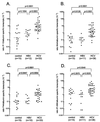Enhanced expression of interferon-regulated genes in the liver of patients with chronic hepatitis C virus infection: detection by suppression-subtractive hybridization
- PMID: 11152506
- PMCID: PMC114039
- DOI: 10.1128/JVI.75.3.1332-1338.2001
Enhanced expression of interferon-regulated genes in the liver of patients with chronic hepatitis C virus infection: detection by suppression-subtractive hybridization
Abstract
Hepatitis C virus (HCV) infection causes acute and often also chronic liver disease. Worldwide, prevalence of infection is estimated to exceed that of human immunodeficiency virus infection fourfold. Because of the lack of appropriate animal models, knowledge of interactions between virus and host is still limited. Assumptions regarding pathogenesis or the activation status of innate antiviral host responses, for instance, derive mainly from clinical observations and from expression analyses of selected genes. To obtain a more objective insight into virus-host interrelationships, we used suppression-subtractive hybridization to compare gene expression in HCV-infected and non-HCV-infected liver tissues samples. Four differentially expressed genes were found: (i) the gamma interferon (IFN-gamma)-inducible chemokine IP-10 gene; (ii) the IFN-alpha/beta-inducible antiviral MxA gene; (iii) the gene encoding IFN-alpha/beta-inducible p44, shown to be associated with ultrastructural cytoplasmic entities within hepatocytes of non-A, non-B hepatitis-infected chimpanzees; and (iv) the gene encoding IFN-alpha/beta/gamma-inducible IFI-56K, a protein recently shown to interact with the eukaryotic translation initiation factor eIF-3. Compared to hepatic gene expression in patients with liver diseases unrelated to viral infections, expression in patients with chronic HCV infection was up to 50-fold higher. While in patients with chronic HBV infection IP-10 was slightly activated as well, the IFN-alpha/beta-regulated genes were not. Revealing a dominance of hepatic interferon-regulated processes in chronic HCV infection, data on the enhanced expression of the IFN-gamma regulated IP-10 support earlier findings and may explain the composition of the hepatic cellular infiltrate. The data on enhanced expression of IFN-alpha/beta inducible genes might be germane to therapeutic considerations.
Figures

References
-
- Ballardini G, Groff P, Pontisso P, Giostra F, Francesconi R, Lenzi M, Zauli D, Alberti A, Bianchi F B. Hepatitis C virus (HCV) genotype, tissue HCV antigens, hepatocellular expression of HLA-A,B,C, and intercellular damage and response to interferon treatment in patients with chronic hepatitis C. J Clin Investig. 1995;95:2067–2075. - PMC - PubMed
-
- Bertoletti A, D'Elios M M, Boni C, De Carli M, Zignego A L, Durazzo M, Missale G, Penna A, Fiaccadori F, Del Prete G, Ferrari C. Different cytokine profiles of intrahepatic T cells in chronic hepatitis B and hepatitis C virus infections. Gastroenterology. 1997;112:193–199. - PubMed
-
- Burgio V L, Ballardini G, Artini M, Caratozzolo M, Bianchi F B, Levrero M. Expression of co-stimulatory molecules by Kupffer cells in chronic hepatitis of hepatitis C virus etiology. Hepatology. 1998;27:1600–1606. - PubMed
-
- Castelruiz Y, Larrea E, Boya P, Civeira M P, Prieto J. Interferon alfa subtypes and levels of type I interferons in the liver and peripheral mononuclear cells in patients with chronic hepatitis C and controls. Hepatology. 1999;29:1900–1904. - PubMed
Publication types
MeSH terms
Substances
LinkOut - more resources
Full Text Sources
Other Literature Sources
Research Materials

